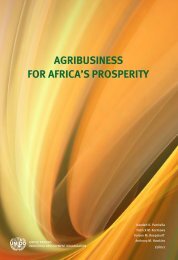Collection of Case Studies 2. - Seas of Change Initiative
Collection of Case Studies 2. - Seas of Change Initiative
Collection of Case Studies 2. - Seas of Change Initiative
You also want an ePaper? Increase the reach of your titles
YUMPU automatically turns print PDFs into web optimized ePapers that Google loves.
13. Pathways towards sustainability: Farmer Organisations in thedriver’s seatAuthor and organisation: VECO/VredeseilandenThis case is one <strong>of</strong> a series specifically prepared by VECO/Vredeseilanden and local partners for the “<strong>Seas</strong> <strong>of</strong><strong>Change</strong>” event. The business partner involved in the case is FAPECAFES.Why is the case an interesting example?The case is interesting because FAPECAFES looks for chain improvements (with the help <strong>of</strong> Ethiquable) forplantains grown as shade trees for c<strong>of</strong>fee. It is also interesting since not much research has been done onbenefits for farmers on intercropping c<strong>of</strong>fee and plantain.1. Context and backgroundC<strong>of</strong>fee and plantain sub-sectors in EcuadorWhile Ecuador was the world’s 10 th biggest c<strong>of</strong>fee exporter in 1990, 10 years later export figures plummeted toless than half <strong>of</strong> their 1990 peak. Ecuador continued to produce c<strong>of</strong>fee with old technologies, resulting in thelowest yields in the world and reducing Ecuador’s competitive strength on the international market –impoverishing tens <strong>of</strong> thousands <strong>of</strong> small farmer families (COFENAC 2011). The c<strong>of</strong>fee sector has been selectedby the Ecuadorian Government as a ‘strategic commodity’, and the Agricultural Ministry has started a 10 yearprogram (with 38 million US$) to reactivate the c<strong>of</strong>fee sector.Despite the absence <strong>of</strong> structural investments in the production <strong>of</strong> c<strong>of</strong>fee, Ecuador has invested a lot in thec<strong>of</strong>fee processing industry, boosting the most modern installations to process c<strong>of</strong>fee into instant c<strong>of</strong>fee. As aresult, Ecuador started importing a lot <strong>of</strong> c<strong>of</strong>fee for the processing industry to have sufficient supply. In responseto this problematic situation, a c<strong>of</strong>fee law was approved – leading to the National C<strong>of</strong>fee Council COFENAC(1995) and CORECAF, (1998) a syndicate <strong>of</strong> the c<strong>of</strong>fee sector. Yet, during the first 5 years since COFENAC,results were not that good, and also CORECAF was not functioning as it should.Plantains (cooking bananas)Ecuador is the world’s biggest exporter <strong>of</strong> bananas and the third biggest <strong>of</strong> plantain. Plantain is a staple food withhigh nutritional value, and constitutes an essential element <strong>of</strong> Ecuador’s diet (used as cooked banana orprocessed products as flour, chips, and pancakes). Currently, the plantain sector employs approximately142,500 people on a yearly basis, supplying both the domestic and international markets with 550,000 tons <strong>of</strong>plantain in 2009. Although the demand for plantain and its derivatives comes mainly from the internal market,international markets demand is increasing.Plantain cultivation is a very inclusive agricultural activity, with women participating in all activities, yet notreceiving a fair enumeration for their work. Main concerns for plantain cultivation is the use <strong>of</strong> chemical productsand the vast quantity <strong>of</strong> waste, with organic alternatives begin in an incipient stage <strong>of</strong> development. Both nationaland regional organisations exist that represent plantain producers, f.e. FENAPROPE and FAPECAFES, which seekto influence policies to improve the development <strong>of</strong> plantain chains for small scale farmers. However, limitedorganisational capacities and issues with representation impede major changes in the field. In response to thissituation, more local initiatives have surged, although they remain somewhat isolated initiatives.<strong>2.</strong> Underlying business modelIntercropping c<strong>of</strong>fee and plantainIntercropping c<strong>of</strong>fee in the shadow <strong>of</strong> banana or plantain plants is a common agricultural technique, mainly usedby small scale farmers, to make optimal use <strong>of</strong> limited land. Moreover, it gives farmers the benefits <strong>of</strong> spreadingtheir risks, both in terms <strong>of</strong> price shocks on the international market and failed harvests <strong>of</strong> one crop. Despitewidespread practice by farmers across Latin America and Central and East Africa, very little research has beenconducted towards the effect <strong>of</strong> intercropping c<strong>of</strong>fee with banana/plantain.56







